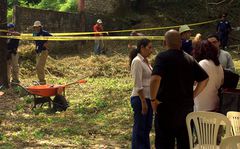Atoyac de Álvarez, GRO. On the October 31 in the Ciudad de los Servicios de Atoyac de Alvarez (former 27th military zone), Guerrero, the third stage of excavations started in the search for the remains of Rosendo Radilla Pacheco and it will end on November 12. This occurs two years after the sentence issued by the Inter-American Court of Human Rights against the Mexican state for his disappearance in August 1974 during the period known as Mexico´s Dirty War.
The previous excavations took place in July 2008 and October 2010. In May 2011 national and international experts previously scanned the selected zone in which a total of 18 anomalies1 were found, and these will be the places where the experts excavate. The Association of Relatives of the Detained, Disappeared, and Victims of Human Rights Abuses in Mexico (AFADEM) said that the excavations have been based on testimonies of victims and relatives of the disappeared. Moreover, AFADEM stated it is essential that members of the army serving at that time testify about the location of the graves. Up until now AFADEM has no knowledge of the military being questioned2.
At the request of Tita Radilla, daughter of Rosendo Radilla and vice-president of AFADEM, experts and specialists of the National Institute of Anthropology and History and officials from the State Attorney General´s Office did a presentation for AFADEM family members at the start of the excavations explaining the methodology used in the scans last May, the process for the third phase and the procedure to follow in the event that they find remains.
The second day of the current excavations ended with some news- unlike the previous two excavations- the team of experts found a coin dated 1976. It is the first time in this zone that evidence has been found relating to the dates in which the alleged events took place.
On finishing this stage of the excavations there will be a Public Act on November 14, in completion of the IACHR´s judgement, in which the Mexican state will recognise its guilt in the disappearance of Rosendo Radilla Pacheco.
On the December 15 2009 the Inter-American Court of Human Rights in the case of Radilla Pacheco vs Mexico made its verdict public. One of its statements was that "The State shall continue with the effective search for and the immediate location of Mr. Rosendo Radilla-Pacheco or, in its case, of his remains, in the terms of paragraphs 335 through 336 of the present judgment".
The PBI Mexico Project has provided accompaniment to Tita Radilla since 2003.
More Information
Comisión Mexicana en Defensa y Promoción de los Derechos Humanos Press Release (Spanish only)
PBI Publications
Bulletin: Mexico before the Inter-American Court
Interview. AFADEM CMDPDH: Demand for Justice for the Disappeared from the Dirty War
Interview. Tita Radilla comments on the IACHR judgement on his father’s case
1 The anomalies are subsurface features. They were detected by high-precision instruments that determine the depth and breadth of them. These anomalies are not necessarily graves or skeletal remains, they may correspond to geological faults, large rocks, rodent burrows, buried foundations, landfills and even roots accumulation.
2 Realizará la PGR nuevas excavaciones para buscar restos de Rosendo Radilla, La Jornada, Monday, October 31, 2011, p. 14

